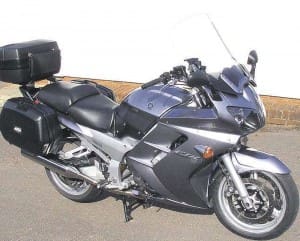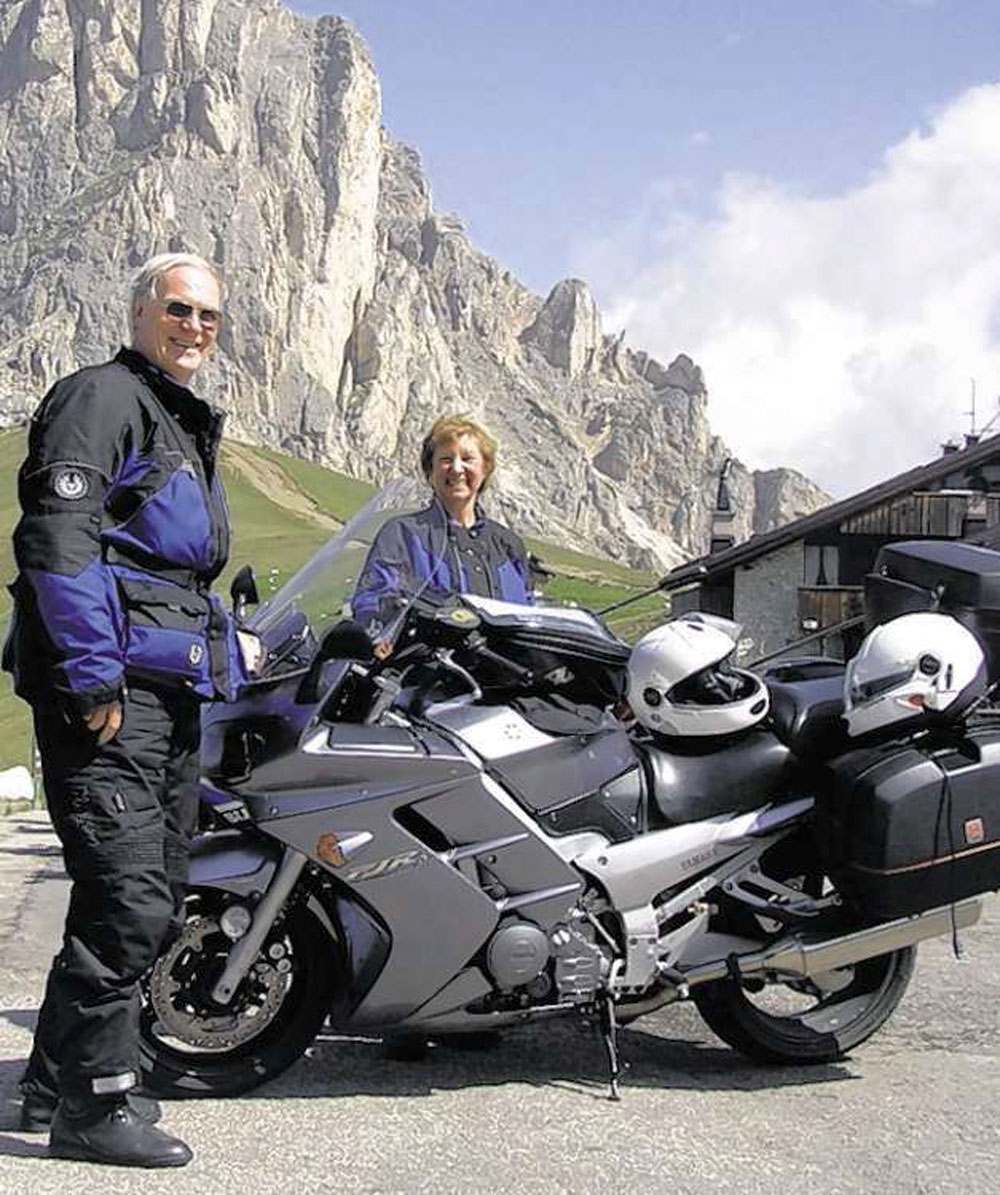Two years and 49,000 miles on an FJR1300 have convinced former Bemsee sidecar champion David Bexley that the Yamaha – with a few mods – is the best big tourer on the planet.
I am not a rider who changes bikes very often because I am of the firm belief that when the unexpected happens I need to know precisely what my machine will and won’t do. I’m sure this policy has helped keep me safe for 47 years and over half a million road miles on motorcycles. I just wish my 20 years on the racetrack had been as pain-free.
I spent nine years on three Yamaha 900 Diversions, but had to go looking for an alternative when that model was discontinued. Shaft drive was a must so the shortlist was short indeed. The Pan European, like the Gold Wing, was a bit too lardy and I couldn’t face owning a current BMW because they are not DIY service friendly. The one bike that remained was the FJR1300.
Shopping around in November 2006 I found a new ABS model for £9000 (list was a steep £10,500). The bike was a 2005 model but the £1500 saving was more than adequate compensation.
Before I report on my FJR experience, I should detail several significant modifications I made in order to end up with exactly the bike I wanted. These were dictated by my desire for a machine that could cover 20,000 miles or more a year, mostly two-up with luggage. I wanted a bike that was comfortable, handled well and had the luggage capacity to carry enough gear for two on threeweek trips across Europe. I have never bought a bike that didn’t need a mod or two and the FJR was no exception.
First priority was the suspension. The stock shock was barely adequate for me on the ‘hard’ position (I’m no lightweight), so two-up with luggage was a no-no. If you are under 12- stone and always ride solo, the OEM shock might be OK but not in my case. The ‘hard’ and ‘soft’ settings ought to be labelled ‘soft’ and ‘softer’. They have just a minor pre-load effect on a sagging rear end. My solution was to fit an Ohlins. This involved a bit of cut and slot for the reservoir to clear the ABS unit and I specified a remote hydraulic pre-load adjuster for convenience. The improvement was well worth the £530 it cost. The downside was it took a lot of juggling with the settings before the rear suspension was as good as it could be. An incidental benefit of the shock change was a very welcome increase in ground clearance, thus solving another problem that has been highlighted in many road tests.
The standards forks are fully adjustable for compression, rebound and pre-load, almost unique on a sports tourer, and a few minor tweaks made them an adequate match for the rear. In this trim, the FJR can be a real scratcher’s tool.
I decided from the start that I would use Givi luggage as I have a variety of cases and it solved the top box requirement. The supplied Yamaha side cases are well made and neatly fitted but an impractical shape and simply not big enough for our extended tours. The Givi equipment fitted faultlessly and the Yamaha cases remain unused. Neither my wife Barbara nor I liked the standard seat because the passenger section slopes forward (not helpful when braking hard). I took care of this with a home brewed affair made out of the generous seat from an old Honda PC800. It now provides a level passenger section and a generous driver seat.
Next, the screen. The stock one was too low for me and, to my surprise, when I offered up a spare GL1800 screen, it needed only minor trimming and hole-drilling. It was intended as an interim solution, but is still in use and works well. I made my own risers for the handlebars to increase comfort as I am 6ft 3in. I also had some nice flat passenger footrests I had made for the Diversion and they fitted perfectly. Final touches were a radiator protector and a front mudguard extender.
Mods done, I was looking forward to putting some miles on the beast, but I was stopped in my tracks by a small oil weep from the final drive output on the engine. No problems getting a main dealer to fix it promptly under warranty but it required engine removal and that is not what you want your new bike to undergo. When I picked it up after the repair I found a horn swinging loose on an untightened bracket and the coolant 500ml short. That’s why, except for warranty problems, I never let anyone else work on my bikes. I prefer to do the work myself and know it has been done right.
Once everything was OK, the miles piled up very satisfactorily with no more problems. My FJR handles well enough to exploit all of the available rubber on any make of tyre and nothing grounds, even two-up. Unsurprisingly considering its massive torque, it eats tyres, rears in particular. I am pleased if a rear exceeds 3000 miles and fronts are doing well to reach 4500. I have very careful records of different makes of tyres I have used under various riding conditions but no clear pattern emerges. They are all perform better than I do so I now use whichever mainstream brand is cheapest at the time. My fuel consumption is 45 to 50mpg (a reliable 200 miles plus per tank) despite that big screen, large panniers and twoman crew. Perhaps my habit of avoiding motorways in favour of A and B roads pays dividends. Still, having a bike for which the cost of tyres amounts to 50 per cent of the cost of fuel per mile is not funny.
The electrically adjusted screen isn’t as great as it sounds because, at its highest, it becomes almost vertical and displays all the airflow qualities of a brickwall. Not clever engineering! I like it for making minor adjustment to my taller screen because it remains nicely angled near the bottom of its travel.
Everybody seems to agree that the jewel in the FJR crown is the engine and they’re not wrong. It pulls sweetly from tickover and doesn’t need to be revved hard to pick up speed very quickly. I don’t often push it over 4000rpm, but a large handful of throttle delivers spectacular performance for such a big bike. Nevertheless, its forte is the relaxed way it deals with any road situation. This is aided by perfect fuelling, which makes rolling on and off the throttle a delight. If there criticism of the engine it is that first gear clunks every time from a standstill. It is bad enough to be BMWembarrassing when the oil is cold, though the rest of the gear changes are sweet and always reliable. Actually, the engine does buzz slightly around 3000rpm but it goes largely unnoticed because of the handlebar and footrest end-weights and the thick soft footrest rubbers.
The brakes are everything you could need. I recall that I did once boil the rear brake fluid trailing the brake on repeated downhill Alpine hairpins.
 The cure was a change to DOT 5 fluid. I normally use only two fingers on the front. The front brake has got a little too much lost lever travel for me but this seems to be normal with the ABS model and the levers are fully adjustable. Speaking of the ABS, it does what it says on the tin and the unpleasant pedal/lever vibrations leave you in no doubt that it has kicked in. Better than a locked wheel though.
The cure was a change to DOT 5 fluid. I normally use only two fingers on the front. The front brake has got a little too much lost lever travel for me but this seems to be normal with the ABS model and the levers are fully adjustable. Speaking of the ABS, it does what it says on the tin and the unpleasant pedal/lever vibrations leave you in no doubt that it has kicked in. Better than a locked wheel though.
Obviously, I can review servicing, but not the costs because I do all my own. I synchronise the injectors regularly but there seems little practical effect even when they are badly out. I feel uneasy leaving oil changes to the 6000-mile intervals recommended and treat my engine to fresh lubricant every 4000 miles, though I don’t use expensive fully synthetic oil.
I service it to the letter of the Yamaha schedule. For example, I carefully grease suspension linkages and there has never been a hint of the seizure problems reported by some owners. Valve clearance is checked at 25,000 miles. No adjustment was necessary which is reassuring because even checking is a pig of a job, so expect a proper 25,000-mile dealer service to be pricy.
The original front brake pads lasted over 25,000 miles and the EBC replacements look set to do the same. At 49,000 miles, I am still running the original rear pads. All three discs look slightly scored but still work perfectly. Otherwise I’ve only replaced a few plastic securing screws that stopped securing.
Nothing else has failed or worn out and it has never broken down. The engine still runs well with no unusual noises. The handling is still taught and the finish has lasted well, though I do clean it regularly. With a complete absence of chrome, a wash usually suffices.
On reflection, if my comments sound rather critical it is because modern motorcycles are so good that I didn’t think to comment on the obvious. It doesn’t ever use oil, it starts first time and ticks over like clockwork. The twin headlights are every bit as good as those on my car and the stainless exhaust is everlasting, unlike my car’s! The instruments are comprehensive and the fuel gauge is accurate. The complicated jigsaw of plastic bodywork never buzzes or rattles and the shaft drive has no adverse effect on handling or suspension. I could go on and on but the acid test is I love it.
If you are looking for a bike that will reliably soldier on towards six-figure mileages and still be more exciting than a ferret down your trousers, I highly recommend the FJR. The only caveat is that high mileages murder the resale price so you’d better be prepared to keep it. Fortunately, that is no hardship.
Tech Spec
Mods: Ohlins rear shock, Givi luggage, Gold Wing screen, customised PC800 seat, purpose-made passenger footpegs and risers
Owner: David Bexley, 64, retired IT consultant and former head of the motorcycle mail order company Hadleigh Custom
Engine: 1298cc liquid-cooled, across the frame four with dohc and four valves per cylinder. Compression ratio 10.8:1. electronic fuel injection. Wet sump
Power: 143.5bhp @ 8000rpm
Torque: 13/7kg-m @7000rpm
Transmission: 5-speed gearbox, wet multi-plate clutch, final drive shaft
Rolling chassis: Diamond alloy frame with box-section swinging arm. Multiadjustable front forks and rear monoshock. ABS brakes. Cast alloy wheels. Tyres 120/70 x17 front, 180/55 x17 rear
Weights and measures: Wheelbase 1515mm, seat height 805mm, dry weight 244kg. Fuel capacity 25 litres



